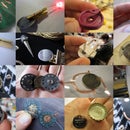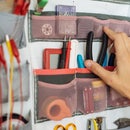Introduction: Pincushion Breadboard Bracelet
Pincushion Breadboard Bracelet combines the wearable "at-hand" functionality of a wrist-worn pincushion, with the electronics prototyping flexibility of a breadboard. This wearable tool might not seem all that useful to you at first, but I would like to demonstrate that a Pincushion Breadboard Bracelet can be an extremely useful tool for for the right purposes. And, that part of what makes it so useful is that if you're wearing it close at hand, it will be there when you need it most.
Step 1: Examples
On the Breadboard Pincushion Bracelet page you'll find a list of examples of Breadboard Pincushion Bracelets that I've made for myself and for friends, and the diverse uses we've found for them....
Step 2: Did You Know...
...that breadboards and pincushions have more in common than might be apparent at first sight?
* Pins and sewing needles fit beautifully into breadboard holes, and they even make for great access points when working with crocodile clips (see image).
* Electronic components can be pressed into pincushions similarly to storing them in ESD foam for shielding and protecting the pins from getting mangled (if you stuff your pincushion with steel wool it even provides the same anti-static effect).
* The Breadboard Pincushion is an example I made to demonstrate the possibility of making a fabric breadboard that retains the functions of both tools (pin storage, electronics prototyping).
Step 3: Materials and Tools
Materials:
- Leather or Tarpaulin (or another sturdy material that does not fray where cut)
- Powermesh
- Mini breadboard
- Sewing thread
- Masking tape
- Velcro or snaps
Tools:
- Scissors
- Sewing machine
- Fabric pen for marking stencil
(- Snap press)
Step 4: Trace and Cut
Print, cutout and trace the breadboard pincushion bracelet pattern pieces.
The pattern pieces are:
* 1 x main bracelet (leather or tarpaulin)
* 1 x powermesh (36 x 90 mm)
(* 2 x Velcro - hooks and loops)
Step 5: Sew
Fold the longer end of the powermesh over and under as shown in the illustration bellow.
Use masking tape to hold the powermesh in place while sewing.
Add on Velcro or snaps as fasteners for closing the bracelet. A watch buckle would also be a nice option.
Step 6: Insert
Insert breadboard as shown.
Step 7: Build
Build a circuit by pressing components into the breadboard through the holes of the powermesh.






